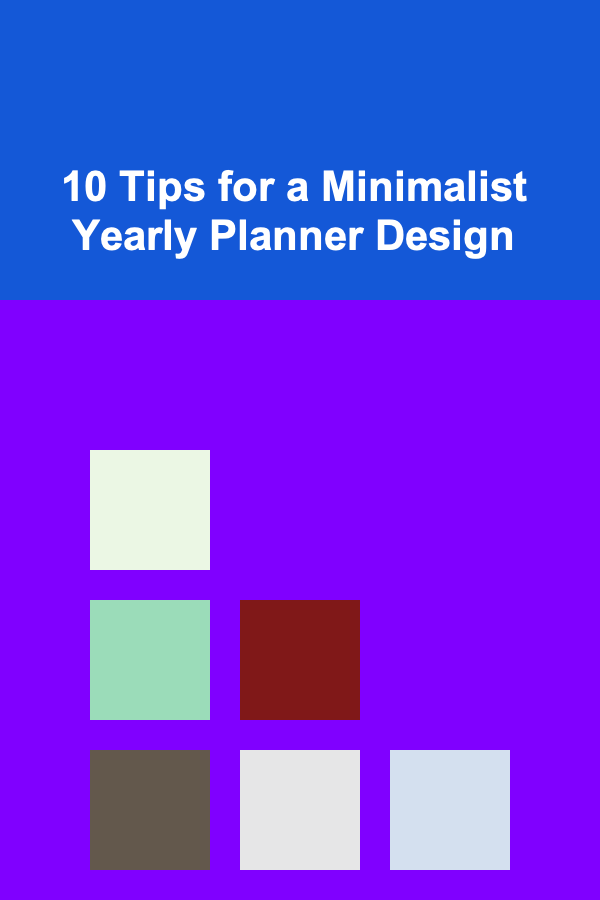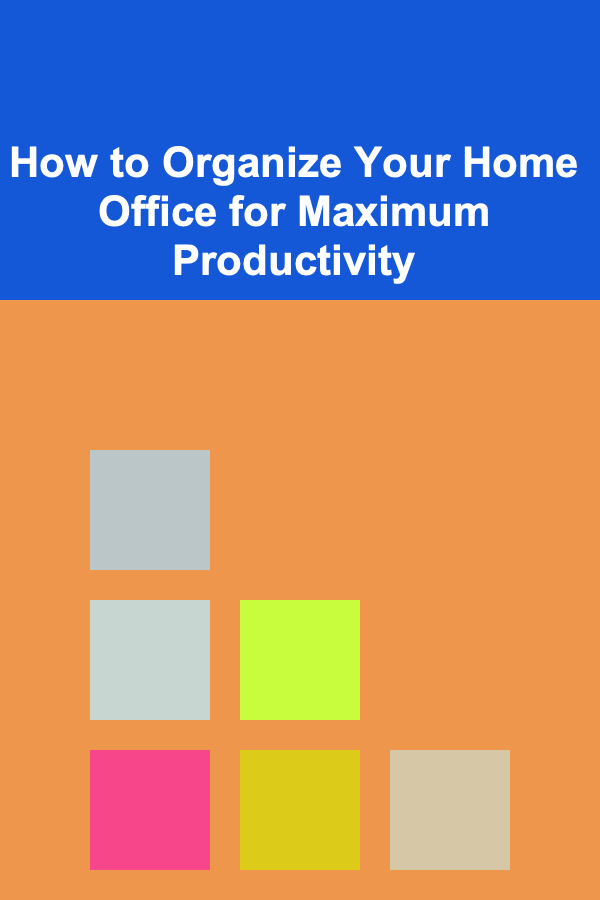
10 Tips for a Minimalist Yearly Planner Design
ebook include PDF & Audio bundle (Micro Guide)
$12.99$8.99
Limited Time Offer! Order within the next:

Designing a yearly planner can be a complex task, especially if you're aiming for a minimalist approach. The minimalist design philosophy revolves around simplicity, functionality, and the removal of unnecessary elements, while maintaining a sense of clarity and ease of use. When creating a yearly planner, the goal is to create a tool that is both visually appealing and highly functional, without overwhelming the user with excessive details.
In this article, we'll explore ten tips to guide you in creating a minimalist yearly planner design that's both beautiful and practical.
Keep the Layout Simple and Clean
One of the foundational principles of minimalist design is simplicity. When designing a yearly planner, it's important to use a layout that allows users to focus on what matters most. Avoid overcomplicating the design with unnecessary decorations, grids, or cluttered pages. Instead, opt for a layout with clean lines, ample white space, and only the essential sections.
For example, your monthly or weekly spreads can be formatted with only the day names and dates clearly visible, with no added graphics or distractions. This will make it easier for users to scan the page and find the information they need quickly.
Design Tip:
- Use borders or subtle lines sparingly to section off areas of the page.
- Limit the use of colors---black and white or muted tones work well with minimalist designs.
- Allow plenty of space between sections to avoid a crowded appearance.
Focus on Key Features and Functionality
A minimalist planner should prioritize functionality over decoration. Think carefully about the core features that your users truly need and streamline the layout to include only these elements. The focus should be on making the planner easy to use and effective, rather than including every feature under the sun.
Consider incorporating the following features:
- A yearly overview to provide a snapshot of the entire year.
- Monthly spreads to outline major events, appointments, or goals.
- A weekly or daily section to jot down tasks, events, or to-dos.
- A section for long-term goals or important reminders.
- Space for reflections or journaling (optional, depending on the user's needs).
Avoid adding complex charts, graphs, or unnecessary sections that might distract from the planner's main purpose.
Design Tip:
- Limit the number of different types of spreads---stick to monthly, weekly, and yearly views.
- Ensure that the features you include align with the goals of your target users.
Utilize Clear, Legible Typography
Typography plays a crucial role in minimalist design, and this is particularly true for planners, which users will refer to frequently. Choose fonts that are easy to read and have a simple aesthetic. Opt for clean, sans-serif fonts for headings and body text. Avoid using more than two or three different fonts to maintain consistency and visual harmony throughout the planner.
Make sure the font size is large enough to be legible but not overwhelming. Since the focus should be on readability and simplicity, avoid excessive font styling like bold, italic, or underlined text unless absolutely necessary.
Design Tip:
- Stick to modern and simple fonts such as Helvetica, Arial, or Futura.
- Create contrast by adjusting font weights rather than using different font styles.
- Ensure that there's adequate line spacing to improve legibility.
Use Subtle Colors and Accents
While minimalist designs are typically centered around neutral colors, incorporating subtle accents of color can add elegance and personality to your planner. Choose a restrained color palette with one or two accent colors that complement the neutral tones. Use these accent colors sparingly, perhaps to highlight important dates, headings, or section dividers.
Avoid using bright, vibrant colors, as they can overwhelm the eyes and detract from the minimalist aesthetic. Soft, muted tones like pastel blues, grays, or subtle golds work well for a refined look.
Design Tip:
- Use accent colors for functionality, such as marking weekends or holidays, rather than for decoration.
- Stick to a limited color palette that evokes calm and clarity.
- Consider using soft grays or off-whites as background shades to maintain a clean, professional appearance.
Incorporate Ample White Space
White space, also known as negative space, is one of the key elements of minimalist design. It creates balance, improves readability, and gives the design room to "breathe." For a minimalist planner, the use of white space is essential in making the content visually appealing without overwhelming the user.
Ensure that there is enough space between the different elements on the page, such as the headings, dates, and task lists. White space helps to guide the eye naturally through the page and makes the planner feel less cluttered.
Design Tip:
- Leave enough room between the date columns, task entries, and headings to prevent the design from feeling cramped.
- Use generous margins around the edges of the page to enhance the sense of spaciousness.
Consider the Binding and Size
A minimalist yearly planner should also be practical in terms of usability and portability. The binding and size of the planner are important factors to consider, especially if users will need to carry it around frequently.
Choose a simple, elegant binding style, such as a softcover, hardcover, or spiral binding, depending on the user's preferences. The size of the planner should be large enough to accommodate sufficient writing space but compact enough to be easily portable.
Consider providing options for both larger and more compact sizes to cater to different user preferences.
Design Tip:
- Opt for a durable but minimal binding, such as a stitched or glued spine.
- Choose a size that balances ease of portability with functionality, such as A5 or B6.
Embrace Simple Icons and Illustrations
Minimalist design relies on visual simplicity, and icons or illustrations should be used sparingly to enhance the design without adding unnecessary clutter. If you choose to use icons (such as for specific tasks or events), make sure they are simple, clean, and consistent throughout the planner. Opt for line-style icons that align with the minimalist aesthetic, avoiding overly detailed or ornate illustrations.
Avoid using illustrations that distract from the content. Instead, use them to complement the design and reinforce the planner's overall functionality.
Design Tip:
- Use icons for common tasks like meetings, birthdays, or important notes.
- Keep the icons small and placed in non-distracting locations, such as next to the text or at the top of the page.
Provide Customization Options
Although a minimalist planner should be straightforward, providing a small degree of customization can make the product more versatile. Offering space for users to add their own sections, whether for tracking habits, setting personal goals, or jotting down notes, allows them to personalize the planner to suit their needs.
You can incorporate simple, clean sections where users can add their own information, without taking away from the minimalist aesthetic. This ensures that the planner is functional for different types of users, from those focused on time management to those who also want to use it for reflection or personal development.
Design Tip:
- Include optional blank pages or sections where users can add their own content.
- Provide light prompts or guidelines for customization without overwhelming the design.
Ensure Easy Navigation
While simplicity is key, the planner should still allow users to quickly and easily find what they need. Thoughtful page breaks, section dividers, and intuitive navigation will make the planner more user-friendly.
Consider including a simple index at the beginning or an easy-to-follow numbering system to guide users through the planner. Make sure there are clear distinctions between different sections (yearly, monthly, weekly, etc.) to avoid confusion.
Design Tip:
- Use minimalistic dividers, such as thin lines or subtle page numbers, to separate sections.
- Ensure that the section titles are clear and easily identifiable without being obtrusive.
Focus on Quality Materials
A minimalist planner should not only look beautiful but also feel pleasant to use. The choice of paper, cover material, and printing quality can greatly impact the overall experience. High-quality, smooth paper that resists ink bleed-through will improve the usability of the planner, while a sturdy, textured cover will make it more durable and pleasant to handle.
Choose materials that reflect the minimalist ethos, such as recycled paper or materials with a natural, unembellished appearance. A simple, well-made planner can enhance the user experience and add an extra layer of sophistication to the design.
Design Tip:
- Opt for high-quality paper that is both sturdy and smooth for easy writing.
- Choose a simple yet elegant cover material, such as faux leather or linen.
Conclusion
Creating a minimalist yearly planner is all about embracing simplicity and functionality. By focusing on clean design, intuitive features, and subtle aesthetics, you can craft a planner that serves as both a practical tool and an elegant object. With these ten tips, you'll be able to design a planner that helps users stay organized, reduces overwhelm, and provides a sense of clarity and peace throughout the year.
By keeping these principles in mind, you can create a minimalist yearly planner that enhances productivity while staying true to the simplicity that defines minimalist design.
Reading More From Our Other Websites
- [Weaving Tip 101] How to Create Complex Jacquard Patterns Using a Manual Loom Without a Computer
- [Gardening 101] Eco‑Friendly Fertilizer Mixes: Turning Waste into Plant Power
- [Personal Finance Management 101] How to Create a Side Hustle for Extra Income
- [Home Storage Solution 101] How to Make the Most of Your Attic for Storage
- [Home Cleaning 101] How to Clean for Renters: Essential Tips for Lease Agreements
- [Personal Investment 101] Creating AI Solutions for Passive Income through Deep Learning
- [Home Storage Solution 101] How to Transform Under Stairs Storage into a Functional Area
- [Scrapbooking Tip 101] Best Techniques for Integrating Fabric Swatches and Textiles into Pages
- [Small Business 101] How to Set Up a Virtual Office for a Small Legal Consultancy Without Overhead
- [Simple Life Tip 101] Best Frugal Travel Tips for Minimalist Backpackers Exploring Europe

How to Create a Festive Holiday Tablescape for Dinner Parties
Read More
How to Make Money Online as a Travel Coordinator: 10 Actionable Ideas
Read More
How to Organize Your Home Office for Maximum Productivity
Read More
How to Promote Lifelong Learning
Read More
How to Paint Miniature Figurines: A Beginner's Guide to Drybrushing
Read More
10 Tips for Developing Leadership Skills in HR Managers
Read MoreOther Products

How to Create a Festive Holiday Tablescape for Dinner Parties
Read More
How to Make Money Online as a Travel Coordinator: 10 Actionable Ideas
Read More
How to Organize Your Home Office for Maximum Productivity
Read More
How to Promote Lifelong Learning
Read More
How to Paint Miniature Figurines: A Beginner's Guide to Drybrushing
Read More